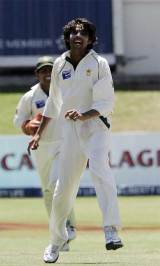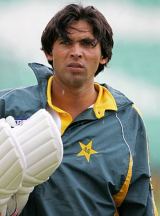The young fox
Less than three years since he made his international debut, Mohammad Asif is a seasoned master of the crafts of guile and deception that separate the good from the merely fast
Osman Samiuddin
11-Aug-2007
|
|

|
A thin line separates supreme self-belief from tasteless arrogance. Sport blurs it evermore and it is readily transgressed. Almost the entire Australian team has taken up residence near this line, making regular sorties on either side. In years gone, the West Indians were original tenants. Success only makes the line less important, but it remains.
Mohammad Asif is a new resident. Five or six years is all he will give to cricket, he states. At Port Elizabeth early this year, Barry Richards watched Asif run up for another spell and coolly predicted, "This, folks, is a 400-Test wickets man right here." The shortest amount of time it took any of the 10 bowlers who have reached 400 wickets to do so is about nine years. "So what's the problem? At my current rate I can do it in that time."
It is no new skin. A school friend was once promised, while watching Pakistan play at Sydney on TV that he, Asif, would play at the ground for Pakistan. He went one better and debuted there.
In only his fourth first-class game in 2001, he bowled alongside Shoaib Akhtar, and though awestruck enough to not ask for tips, he wasn't intimidated. "I was bowling and had a longer run-up then. Our over-rate was slow, so Shoaib bhai says, 'Hurry up, bowl quickly.' I worried and bowled one over quickly, but he said that's still too slow, get quicker. He was coming from such a long run-up, he thought he could save time by getting me to cut my run. Eventually I said, 'Shoaib bhai, bowl yourself. I can't do this.'"
Then there is the recent, more celebrated, encounter with the late Bob Woolmer. It goes like this. Asif makes a tight, wicketless Test debut, until Adam Gilchrist appears. Asif is dropped for the ODIs. Fatherly Woolmer tells new charge not to get dispirited. Work hard, keep the chin up. Young charge responds, "Bob, this is my place. Nobody can take it. I am going away for a bit, but I will be back soon to reclaim what is mine." Then adds that he was picked for the wrong Test: "Had they picked me for Perth, I would've done something."
He is not the freakshow that is Andre Nel, nor the shrinking violet that is Irfan Pathan. He chats up batsmen like a helpless flirt. "I ask what type of shot is that, to drive - just engage them in normal conversation." He grins and says it works well.
You decide, then, what side of the line he is on. Take into account what Woolmer said once: "He is humble and confident; very determined, hates to lose, and backs himself." Certainly he has in himself, in his abilities, absolutely no doubt. Take into account, too, that he is young, and youth gets leeway. But, most of all, consider that nobody who has seen him doubts that he is the most promising pace bowler in the world today. If everyone knows it, why wouldn't he?
***
|
|
The craft has decreed that Asif is the antichrist of pace, the anti-pace superstar. Since 1976 Pakistan has obsessed over pace. When boys hit puberty, they grow whiskers and pimples, the balls drop, so too the voice, and they extend run-ups, add a leap, a glare, and a yard or three of pace. They want to break stumps, hit heads, shatter toes, crack bones, and knock the wind out of you. Even those without genuine pace strut around pretending otherwise. Of each new speedster, the first question asked is of his pace. Always there is a rural legend, some villager who can't count the steps in his run-up, doesn't have shoes, doesn't know what a cricket ball looks like, but scares the bejesus out of batsmen.
This to Asif is death a million times over. It boils his blood, makes his skin crawl. An innocent question - about whether his optimum speed fell after injury - induces this magnificent rant: "See, you are asking that question. Pace is nothing. All I'm concerned about is how batsmen get out. I don't want to scare or hit him. Who gets out by being hit on the head? I want him out, I don't care how it happens. Legbreak, offbreak, fast, slow ball, I don't care.
"People say my pace is slow and are not happy. People are not happy with God either, so why listen to them? People have this thinking, that we need pace. Basically this is my opinion: our batsmen are scared of pace. Older players were scared of fast bowlers, so they think only they can get wickets."
He argues, correctly, that Wasim Akram wasn't about pace, but maybe not so correctly that Waqar Younis of the late nineties (era rather than mph) was better than the rapid, afro-ed original. Unsurprisingly those upright beanpoles Glenn McGrath, Shaun Pollock, and Richard Hadlee are used to prop up the case against pace.
***
Asif's bowling soul is that of the craftsman. It is this craft, the chiselling away at men's techniques, the chipping of their resolve, deceptions in line, length, seam, that holds him, that he cannot stop thinking about. Dismissals are built, nurtured over time, over by over, session by session, with nip n' tuck, then put away, zealously guarded in his head until the next encounter.
At Colombo last year, in his breakthrough series, he enacted upon Kumar Sangakkara the seamer's three-card: go across, make him leave, go across, make him leave, bring it in, watch him exit, bowled offering no shot. When recalled, he corrects it. "Not three balls but three overs I worked on him. I got him so pukka on one line that when I brought one in, he had no option." VVS Laxman was twice bowled by offcutters in Karachi last year, a gap between bat and pad Asif had been eyeing from the previous Test.
Details matter. He plans spells a day in advance, strategies even before. He is already preparing for tasty challenges against South Africa, India and Australia. He has decided he knows their batsmen, what they do in situations, how they react. The game has to be upped.
He has odd takes on batting. Rahul Dravid is good to bowl at, "because you can settle into a rhythm against him". Virender Sehwag is too unpredictable, yet Kevin Pietersen, who Asif so memorably mastered, is ideal because "he rushes, attacks too much too soon. It becomes easier for me."
|
|

|
He plays patience: I have it, do you? He'll bowl over after over of one swing, before suddenly changing tack, for surprise. Jacques Kallis annoyed him because he has his bubble. "He said he wouldn't play a shot against me, even though I kept telling him to." Kallis waited it out, just, but it was a mighty running battle. Patience is not a Pakistani bowling virtue, though admittedly, they haven't often needed it.
There is occasional trickery but, like a magician, the secrecy of his craft - or what secrecy there can be in this age of super slo-mo - is paramount. English commentators picked up a cute sleight of Asif's bowling hand: nearing his delivery stride, he shows the batsman one side of the ball before apparently flipping it around with his ring finger as the arm goes over. Maybe.
"Tim Boon [the Leicestershire coach] spotted it in a match. The ball was reversing and the batsman was picking it from its shine at the start of my run. One ball which he left came in and bowled him. The shine was on the outside at the start but it came in. Boon asked how it was done. We had a bet on about dismissing him with the old ball. If it was with the new ball, I would've gotten him out within three balls." So how do you do it? "I can't show people." It's not unique, as Andy Roberts and Rana Naved-ul-Hasan have apparently practised it, but it's special.
He attended the MRF Pace Academy in 2005 for 10 days, and though it wasn't much use, he says Dennis Lillee offered him one golden nugget, "which if anyone applies to their bowling will benefit them greatly". Naturally he doesn't say what it is, on, off, or around the record.
***
All that is Asif comes essentially from Sheikhupura, an hour's drive on a good day from Lahore. It isn't as nondescript as it might first sound, though neither is it as royally blessed as it once was. Alexander visited, and the Mughal emperor Jahangir used to hunt there. It was his town, initially called Jahangirupura. The current name comes from the nickname Sheikhu baba that Jahangir's father Akbar gave him. Mughal traces are plenty. Waris Shah, who gave the world Heer-Ranjha, was born here, as was Guru Nanak Devji.
More famous are the town's fast men, though they jarred fashion rather than followed it. Aaqib Javed provided unrewarded intelligence in a time of pace, bluster, and reverse. And until form heartlessly deserted him, Rana had less speed but a heftier bag of tricks and greater spirit than most.
Asif, born nearby in Machipur, is of this bent. Cricket happened on the Sheikhupura roads near the school with a tape ball, and the famed Gymkhana Club was where he began learning the craft, under the tutelage of first-class cricketer and hearty leggie "Cuptaan" [Mohammad] Haroon.
|
|
"He instilled many traits," says Asif. "Using the crease, angles, the seam - he got that into me early. As captain he kept four slips on cement pitches. That's great for the confidence of any bowler. He taught me a lot about the brains behind bowling."
The club was, he remembers, intensely competitive, brimming with age-group- and full internationals: among the likes of Aaqib, Rana, and Kashif Raza, Asif "got competitive" and tried to break through. "The competition was such that in big games big players sat out. When we had a chance, we bowled our hearts out because we wouldn't get another easily."
Here emerged the base of the easy, loose, non-strenuous, eminently repeatable action. It's been touched since, but lightly. He points out that since his success, talk of the front arm falling and some such has been absent. The stamina he remembers always having, energy forever conserved in spells. Colombo's overbearing humidity couldn't prevent a 12-over mid-afternoon spell ("only I know how bad I felt after"). In South Africa 12 seemed the minimum spell, and in ODIs 10 on the trot happens often.
His first-class debut duly came in October 2000 against Peshawar, his fortune being that Sheikhupura was then a first-class team. Khan Research Laboratories (KRL) employed him the following season, where Mohammad Wasim and Ali Naqvi took him in. Prominence arrived with a six-wicket haul the next season, and thenceforth he grew. KRL reached the 2002-03 Quaid-e-Azam final with Asif's 28 wickets. Victims and plaudits came readily, among them Rashid Latif early on, impressed with Asif's accuracy and seam.
The radar still defines him, though not so much in ODIs presently. Still it's worth noting that he sent down the first Twenty20 international maiden. Only three others have done likewise, none taking two wickets in the over as he did.
It is no trick, he says. Take what you can from the heavens and mix with sweat and blood. As with Akram and Imran Khan, nets are a serious business. "When I practise, my aim is that batsmen shouldn't go back or forward. Between front and back foot is the length I want."
Aaqib et al drool about the wrist position and the seam, how it comes out wobbly, thus disguising itself, yet uncannily always lands straight. "Swing, batsmen can pick, but seam is not so easy to spot. Some is god-gifted, but basically I work damn hard in nets."
In 2004 he broke through big. Sheikhupura was no longer first-class, so he moved to Sialkot via Quetta. In the midst of a 28-wicket burst in five games in October and November that year, he was called for a fast bowling camp. Woolmer, overseeing, concluded: "He swung the ball a lot and bowled good players out. He looked comfortably the best."
Mohammad Yousuf told Asif first of his selection for Australia. Could you believe it? "Of course. Why wouldn't I?"
|
|

|
The story since is more familiar, though there are unheard tidbits. He maintains firmly his satisfaction with a flat debut: "I batted two hours on that pitch, so what chance did I have? Yet people said I was a Fokker."
There was hard work at home thereafter, where, he insists, he didn't change anything: "What change? Everything was fine. I took nearly 100 wickets in all matches. My comeback wasn't magic, just hard work."
He surfaced again nationally in a side match against England in November 2005, taking 10 wickets and prompting Michael Vaughan to wish him luck for the Test. He wasn't picked for the entire series, but the rivalry with KP began with that game.
"When he came, Strauss was batting. Pietersen asked what I was doing. Strauss said outswing, so obviously I brought it in and trapped him plumb." He says it as might a fox. Over the next year much the same happened to other batsmen globally, so often that he judges all the spells of his last seven Tests equally memorable.
There is a blot, one that will require many years like the one past to wipe away. He won't talk about the drugs that should have seen him out of the game for a while. He was distraught then, barely audible on the phone, and he's still not quite so firm when saying "No questions". He mutters something about humility and how the fever of celebrity that once afflicted him is gone. An uneasy footnote it makes, though it reveals much about how he is viewed that he elicited much more sympathy than Shoaib did.
He launches briskly into a soliloquy about the domestic game, before revealing that people doubted his talent early on. No pace, too skinny, what would he do? "People kept telling me from the start, I can't be a cricketer, can't be a bowler. The more people say this, the harder I try to prove them wrong."
Did the experience dent him? Difficult to say, but few doubts hover over him now. Greatness, in fact, is expected. He has to prove everyone right, which may be harder than proving them all wrong.
Osman Samiuddin is Pakistan editor of Cricinfo